The Bald Eagle is very well known among the Eagles as it is a national emblem of the United States. Kids are usually fascinated by the bald eagle and often love to pick them as a topic for their home assignments. We have gathered complete Bald Eagle Facts For Kids that will help kids in learning all about the American Bald Eagle. They are going to learn why they are called bald eagles, their scientific classification, identification, characteristics, size, weight, height, colors, lifespan, habitat, diet, prey, hunting, food chain, flight, call symbolism, importance, speed, swimming, life cycle, reproduction, nesting season, nest, eggs, baby bald eagle and many other American Bald Eagle Facts that you will love to know.
Bald Eagle Facts For Kids
1. What Is A Bald Eagle
The bald eagle is a bird of prey. It is the only eagle native to North America. Due to this fact, it was chosen as the national emblem of the United States in 1782. It was a spiritual symbol for the native Americans for way longer than that.
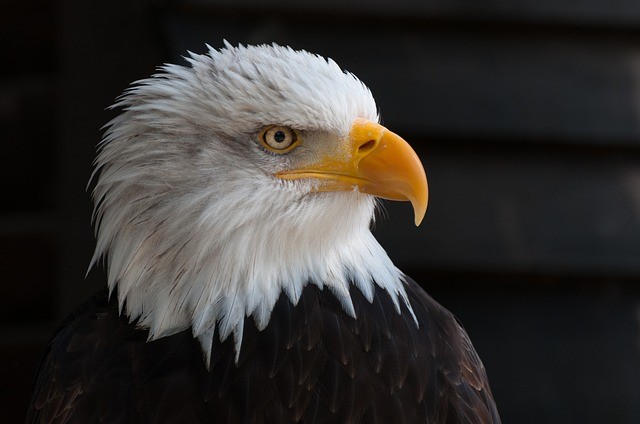
2. Why Are Bald Eagles Called Bald Eagles
- The bald eagle isn’t bald.
- Its head is white-feathered in contrast to the rest of its dark brown body and wings, due to which it appears to be bald from far away.
3. Bald Eagle Scientific Name
- The scientific name of the Bald Eagle is Haliaeetus leucocephalus.
4. Bald Eagle Classification
| Kingdom: | Animalia |
| Phylum: | Chordata |
| Class: | Aves |
| Order: | Accipitriformes |
| Family: | Accipitridae |
| Genus: | Haliaeetus |
| Species: |
H. leucocephalus
|
5. What Does A Bald Eagle Look Like – Bald Eagle Identification
Adult Bald Eagle
- The head of an adult bald eagle is covered in white feathers, while the whole body and wings are covered in dark brown feathers.
- Its feet, beak, and irises are colored bright yellow.
- There are no feathers on its legs and its powerful toes are short and have large talons.
- Its yellow beak is large and shaped like a hook.
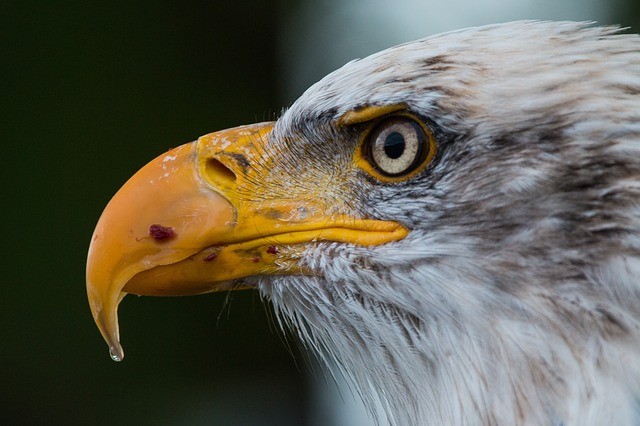
Immature Bald Eagle
- The feathers of an immature bald eagle are dark brown with a messy white streaking. This streaking goes away when the bald eagle reaches sexual maturity, typically at the age of 3 to 5 years.
- Its beak is black with a yellow tip, which distinguishes it from an adult bald eagle.
- An immature bald eagle is similar to an adult bald eagle in the rest of the physical aspects.
6. Bald Eagle Characteristics – Bald Eagle Description
- The bald eagle is among the largest birds of North-East America.
- When it flies, its wings are spread straight out and the feathers at the tips of the wings are separated and its tail is fanned open.
- Its height is 30 inches.
- Male bald eagles weigh 8 to 10 pounds, while female bald eagles weigh 10 to 14 pounds.
- Its wingspan from 6 to 7 feet.
- There are almost 7,200 feathers in an adult bald eagle.
- The head of an adult bald eagle is covered in white feathers, while the whole body and wings are covered in dark brown feathers.
- The large beak of an adult bald eagle is yellow and shaped like a hook.
- The feathers of an immature bald eagle are dark brown with a messy white streaking. This streaking goes away when the bald eagle reaches sexual maturity, typically at the age of 3 to 5 years.
- The beak of an immature bald eagle is black with a yellow tip. It turns yellow gradually over time as the bald eagle reaches its maturity.
7. How Big Is A Bald Eagle – Bald Eagle Size
How Tall Is A Bald Eagle – Bald Eagle Height
- The average height of a bald eagle is 30 inches.
How Much Does A Bald Eagle Weigh – Bald Eagle Weight
The average weight of a bald eagle is:
- Male – 8 to 10 pounds (3.6 to 4.5 kg)
- Female – 10 to 14 pounds (4.5 kg 6.3 kg)
What Is The Wingspan Of A Bald Eagle – Bald Eagle Wingspan
- The average wingspan of a bald eagle is 6 to 7 feet (1.8 to 2.1 meters).

8. Bald Eagle Size Comparison – Bald Eagle Size Compared To Human
- The average human height in the United States is 5 feet 9 inches.
- The average bald eagle’s height is 2.5 meters.
- According to this information, a bald eagle isn’t even half as tall as an average man.
- However, the average wingspan of a bald eagle is 6 to 7 feet, which is longer than the average height of a man.
- Hence, a bald eagle is shorter than a man in terms of height, however, if we compare its wingspan with humans, we can see that a bald eagle is longer than the average man.
9. What Color Is A Bald Eagle – Bald Eagle Colors
- The pattern, color, and arrangement of the feather covering a bird are called Plumage.
- The bald eagle experiences the most varied plumage changes over five years among all the birds in North America.
- A bald eagle is born with a white fluffy down and it undergoes the following plumage changes:
- The white down changes to a gray woolly down within the first four weeks of its birth.
- It starts growing brown and black feathers at the age of five weeks.
- It is fully covered in feathers at the age of ten weeks and stays covered in black feathers for the first year.
- During the next four years, the bald eagle continuously undergoes plumage change until it reaches adult plumage at the age of five years.
- Its eyes are dark, which turn yellow over time.
- Its beak transforms from gray-black to bright yellow.

10. How Long Do Bald Eagles Live – Bald Eagle Lifespan
- The lifespan of a bald eagle is 20 years in the wild, where the oldest bald eagle lived up to 38 years of age.
- Its lifespan increases in captivity. A bald eagle kept captive in New York lived for almost 50 years.
11. Bald Eagle Head
- The head of an adult bald eagle is covered in white feathers.
- The eyes of a bald eagle have pale yellow irises.
- The large beak of an adult bald eagle is yellow and shaped like a hook.
12. Bald Eagle Talons – Bald Eagle Talon Size
- A bald eagle has 4 talons on both feet which are similar to a dog’s nails – one at the back of a foot and the other three on the front of a foot.
- The talon at the rear is called a Hallux talon and is longer than the other talons. It is longer in females than the male bald eagles.
- The hallux talons are:
- 2 inches long – Female Bald Eagles
- 1.25 inches long – Male Bald Eagles
13. Where Do Bald Eagles Live – Bald Eagle Habitat
- The bald eagle is usually found in areas close to water bodies because it loves to eat fish.
- It prefers the tallest hardwood or coniferous trees for nesting such as the oak tree or pine tree.
- It is mostly found in:
- Wetlands
- Coasts
- Lakes and rivers
- Marshes
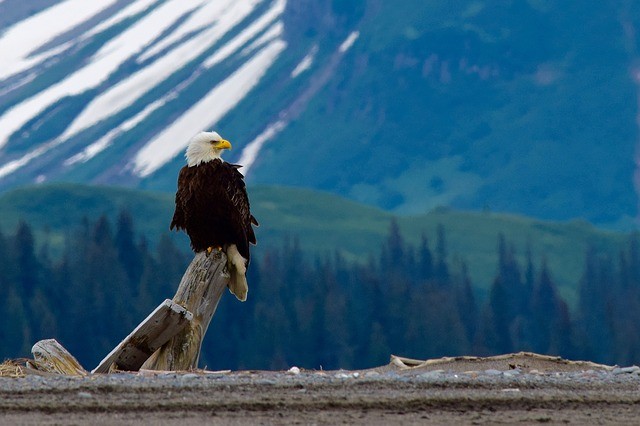
14. Bald Eagle Habitat Map – Bald Eagle Range Map
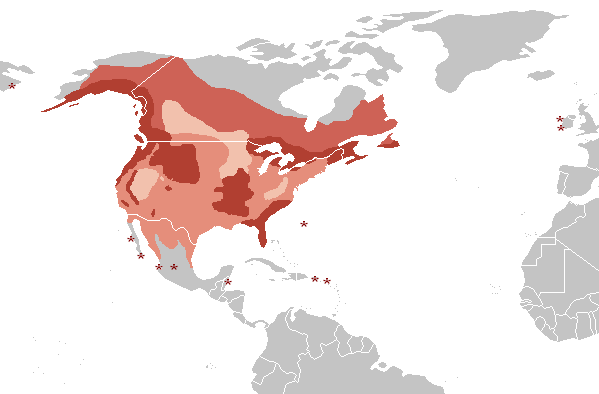
15. Bald Eagle Locations – Where Are Bald Eagles Found
- The bald eagle is found in:
- The entire United States
- Northern Mexico
- Canada
- Alaska
16. Bald Eagle Territory
- The bald eagle is a territorial bird.
- It sets up its nest in its territory.
- It is often seen defending its territory against intruders such as:
- Raptors
- Ravens
- Coyotes
- Foxes
17. Bald Eagle Florida
- Florida is one of the states where the densest concentration of nesting bald eagles is found.
- There are around 1,500 pairs in Florida.
- These pairs are distributed among the lakes, rivers and coastal areas throughout the state.
18. Bald Eagles In Texas
- The Bald Eagles move to Texas in August and stay there till late May.
- The breeding pairs make nests near large aquatic environments:
- Ocean coasts
- Reservoirs
- Large lakes
- Rivers
- Marshes
- Swamps
- There were around 149 nesting pairs in Texas in 2004.
- In 2004, most of the nests found in Oklahoma were along the Arkansas River.
- In 1998, most of the breeding pairs in Colorado were found nesting in the riparian areas.
- In 2005, most of the bald eagles in Arizona were found near lakes and perennial rivers.
- Currently, the bald eagles are mostly found in the south-eastern region of Texas.ƒpicture
19. What Do Bald Eagles Eat – Bald Eagle Diet
- The primary food source of a bald eagle is fish.
- However, it also eats a wide variety of other animals and birds.
- Its preys include:
- Waterfowl
- Squirrels
- Prairie dogs
- Raccoons
- Rabbits
- It also tends to steal food from other animals like eagles and birds, or scavenge.
- A bald eagle’s stomach is the size of a walnut. However, it can eat food weighing up to one-third of its body weight.
- There is an area in its body called crop, where it can store food. It allows them to survive without eating for days.
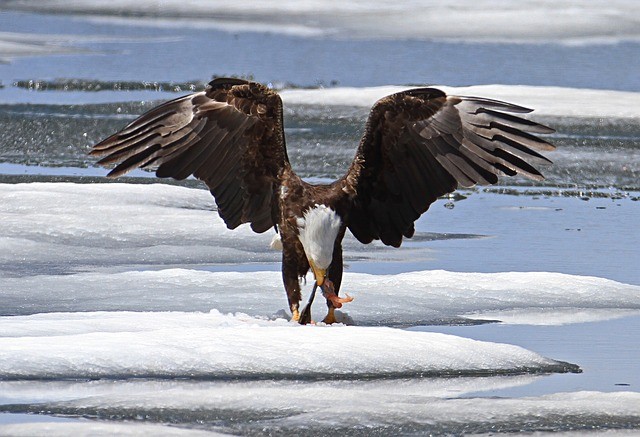
20. Bald Eagle Prey
- A bald eagle mostly preys on:
- Fish
- Waterfowl
- Squirrels
- Prairie dogs
- Raccoons
- Rabbits
21. Bald Eagle Hunting – Bald Eagle Attack
- The bald eagle is a bird of prey. It hunts for its food unlike other birds that eat seeds and insects.
- The bald eagle’s vision is five times sharper than a human being. It can spot a rabbit as far as a mile away. Also, it has a remarkable depth perception because the vision from both its eyes overlaps.
- It flies great distances to find worthy prey.
- It kills its prey with its curved and sharp talons. These talons are very powerful and have a crushing force of 400 pounds per square inch (psi) per talon.
- It also eats the bones of its prey. The acid in its digestive system is capable of dissolving bones.
- It carry a prey as heavy as one-third of its body weight.
- If a fish is too heavy for a bald eagle to lift, it drags it towards the shore while still holding on to it with its talons.
22. Bald Eagle Food Chain
- The bald eagle lies at the top of its food chain.
- Due to its position in the food chain, it is highly vulnerable to toxic chemicals in the surroundings because it is concentrated from lower links to upper links in the food chain.
23. How Fast Can A Bald Eagle Fly – Bald Eagle Speed
- The bald eagle is an exceptional flying bird.
- It can soar on thermal convection currents in the air.
- It can fly at different speeds:
- Gliding and Flapping – 56 to 70 km/h (35 to 43 mph)
- Carrying fish – 48 km/h (30 mph)
- Diving vertically – 120 to 160 km/h (75 to 99 mph)
24. Bald Eagle Call – Bald Eagle Screech – Bald Eagle Noise
- The bald eagle has a weak-sounding call as compared to its size and strength.
- Its calls are high-pitched whistles and piping notes.
- A female bald eagle can produce a high-pitched note which is unlike any other calls in nature. It repeats this note to signal its readiness for copulation.
25. What Does The Bald Eagle Represent – Bald Eagle Symbolism
- The bald eagle was selected as the national emblem of the United States on June 20, 1782.
- Benjamin Franklin was against the selection of the bald eagle as the national emblem because he thought that it had a bad moral character. According to him, the bald eagle is similar to men who are lousy and live by robbing others.
- Despite the opposition, the bald eagle was chosen to represent the new nation in 1789.
- It symbolizes freedom, long life, strength and immortality.
- Its symbol can be found on the:
- backs of the gold coins
- silver dollar
- half dollar
- quarter
- Great Seal of the United States
26. Why Is The Bald Eagle The National Bird
The bald eagle is the national bird because:
- it is the only bird purely native to the United States.
- it represents the freedom, strength, long life, and immortality of the United States.
27. Why Is The Bald Eagle Important
- The bald eagle is a bird of prey which means it hunts for its food.
- It is an important part of the ecosystem and helps keep the population rate of some animals (prey) in control.
- It eats rodents and rabbits which reproduce rapidly.
- If the bald eagles were removed from the ecosystem, its prey population might grow uncontrollably and destroy the ecosystem.
- Hence, the bald eagle is important for maintaining a balance in the ecosystem.
28. Bald Eagle In Flight – How High Can A Bald Eagle Fly
- The bald eagle can fly at a maximum altitude of around 10,000 feet.
- It usually soars to the maximum altitude and then covers ground by gliding.
- It has been estimated that the bald eagle can fly non-stop for 2 to 4 hours. It can fly for 6 or 7 hours in an emergency.
29. Bald Eagle Swimming
- A bald eagle is capable of swimming.
- Whenever a bald eagle gets hold of an aquatic prey too heavy to lift, it holds on to it and rows it to the shore by doing a breaststroke. Though, the eagle should be fairly close to the shore.
30. Male And Female Bald Eagles – Male Vs Female Bald Eagle
There are 4 characteristics that differ between the male and female bald eagles:
- Size
- Talon Length
- Beak Depth
- Voice
Male Bald Eagle
- The male bald eagle in a mating pair is smaller in size as compared to the female:
- Length – 30 to 34 inches
- Weight – 8 to 10 pounds
- Its hallux (back-facing talon) is shorter than a female.
- Its beak depth is lower.
- It produces higher-pitch sounds.
- A young male has lesser beak depth and shorter foot pads.
Female Bald Eagle
- A female bald eagle is larger than a male by approximately one third in size. Their body lengths are:
- Female Bald Eagle – 35 to 37 inches
- Male Bald Eagle – 30 to 34 inches
- Its hallux (back-facing talon) is longer than a male.
- The height from the top of the beak to the bottom is called the depth of the beak. Female bald eagles have deeper beaks as compared to males.
- It produces lower-pitch sounds.
- A young female has a deeper beak and longer foot pads.
- The talons or hallux of a female bald eagle on the backsides of both its feet are larger than a male.
31. Bald Eagle Life Cycle
The Egg
- A bald eagle’s life cycle starts from an egg.
- A female bald eagle usually lays 2 eggs in its nest, though it can lay up to 4 eggs.
- She sits on these eggs for 30 to 50 days for incubation. The males may also participate in incubating the eggs.
- The length of the incubation period depends on the climate.
Hatchling Stage
- A young bald eagle hatches after the incubation period.
- It is completely helpless at that time and depends solely on its mother for food.
- The weight of a newly hatched bald eagle is about 85 grams.
- The first hatchling is advantageous over the other hatchlings in terms of age and size. It grows bigger and stronger at a faster pace.
- The rest of the hatchlings may starve to death if they don’t struggle hard enough to get food from their mother.
- A bald eagle is a hatchling for the first 10 to 12 weeks of its life.
Fledgling Stage
- A bald eagle leaves its nest for the first time after it becomes fully feathered at the age of 10 to 12 weeks. This process is called “Fledging” and the bald eagle is now a Fledgling.
- It is time for the young bald eagle to start flying and hunt for food.
- It returns to its nest and stays with its parents for another month, while it continues learning to fly.
- A bald eagle becomes independent at the age of at least 16 weeks.
Juvenile Stage
- Even after becoming completely independent, a juvenile bald eagle faces survival challenges.
- About 60 to 70 percent of juvenile bald eagles do not make it through the first winter alive.
- The juvenile migrates to a winter territory for hunting, if prey isn’t available.
- During this stage, the juvenile may return to its parents’ nest every once in a while.
- It reaches sexual maturity at the age of 4 to 5 years.
Maturity Stage
- When a bald eagle reaches sexual maturity, its beak turns bright yellow and so do its eyes.
- Its wingspan is almost 7 feet (2 meters) by this time.
- It forms a pair with another bald eagle for life and they build a large nest.
- A pair of adult bald eagles has no predators except humans and they can live up to 30 years. However, the average lifespan of a bald eagle is 20 years in the wild.
32. Bald Eagle Reproduction
Bald Eagle Mating Ritual
- The bald eagles perform different courtship rituals to strengthen the bond with their mates.
- The most famous of these rituals is the “Cartwheel Courtship Flight”.
- A pair of bald eagles fly high into the sky, lock their talons with each other and then fall towards the ground, spinning like a cartwheel. They let go to break their fall at the very last minute and sometimes even hit the ground.
- The pair may also chase each other before doing this ritual.
- It has been observed that the non-breeding pairs may also engage in this ritual.
- Another ritual performed by a bald eagle is the “Rollercoaster Flight”, where it flies up and dives steeply, flies up again and dives again.
Bald Eagle Mating
- A pair of bald eagles ramps down the aerial displays and focuses on intimate behaviors as it gets closer to copulation.
- When the female is ready to mate, she catches the attention of the male by calling and bowing down to him.
- The male climbs onto the back of the female and aligns his cloaca (reproductive organ) with hers to transfer sperm.
- The pair copulates numerous times per day during the breeding season.
- After the female lays eggs, the male and the female take turns to sit on the eggs for incubation.
- A pair of bald eagles may not mate during their first year together. They may even spend several years together in order to assess each other or their nesting area, before mating.
- Bald eagle pairs usually last for life. A bald eagle looks for another partner only if its first partner dies. The divorce rate among bald eagles is lower than 5 percent.
- The bald eagles have also been observed mating in triads, which usually consists of 1 male and 2 females. These triads are capable of producing large clutches and all the adults bring food for the hatchlings.
33. Bald Eagle Nesting Season
- The bald eagles choose a nesting site in an area close to water, where prey is abundantly available.
- They start building their nests 3 to 1 months before mating, and is a part of the breeding process.
- There are multiple stages of the nesting season:
- Re-occupying the territory
- The bald eagles return to their nest every year and re-occupy their hunting territory.
- Nest Building / Repairing
- A pair starts building/repairing its nest the first day it arrives.
- Courtship and Mating
- Egg Laying and Hatching
- Growth and Fledging
- Abandoning the nest
- At the end of the nesting season, the pair abandons its nest and migrates to other areas to look for food.
- Re-occupying the territory
- The nesting season begins at different times in different regions:
- Southern Areas – November and December
- Minnesota – January
- The bald eagles return to their nest every year towards the start of the nesting season.
34. Bald Eagle Nest
- Among the North American birds, the bald eagle builds the biggest nest.
- It can be up to 4 feet deep and 5 feet wide.
- It can weigh up to 1.1 tons.
- The ideal locations for a bald eagle to build its nest are forests and areas near rivers or lakes. These areas provide drinking water, fish for food and trees for shelter. Furthermore, the bald eagle can raise young ones and teach them hunting.
- It builds its nest on cliffs and the highest trees in a forest.
- The purpose of selecting the highest possible location for building its nest is a clear view of a bald eagle’s territory and possible threats.
- The male and female bald eagles bring sticks to reinforce the structure and place soft grassy material in the middle for eggs. The nest grows bigger and bigger each year as the eagles continuously bring sticks and reuse the nest each year.
- The nest of a bald eagle is called an “Aerie”.
- The bald eagle is a territorial bird, and a pair returns to its nest each year for breeding. They may build multiple nests in their territory and alternate between them each year.
Bald Eagle Nest Size – Largest Bald Eagle Nest
- The average nest of a pair of bald eagles has the following properties:
- Depth – 4 feet
- Width – 5 feet
- Weight – 1 ton
- The largest bald eagle nest ever recorded was in St. Petersburg, Florida. Its dimensions and weight are given below:
- Width – 9.5 feet
- Depth – 20 feet
- Weight – 3 tons
How Much Does A Bald Eagle Nest Weigh – Bald Eagle Nest Weight
The average weight of a bald eagle nest is 1 ton.
35. Bald Eagle Eggs
- The bald eagles lay eggs in the United States at different times across different regions:
- Florida – October
- April or May – Northern United States
- A female bald eagle lays 2 to 4 eggs per brood.
- There is only 1 brood if any, in a nesting season.
- A bald eagle’s egg is dull white in color without any markings.
- The dimensions of an egg are:
- Length – 2.3 to 3.3 inches (5.8 to 8.4 cm)
- Width – 1.9 to 2.5 inches (4.7 to 6.3 cm)
- The egg of a bald eagle weighs between 110 to 130 grams.
- The eggs are incubated over a time period of 40 days.
Bald Eagle Egg Size
- The dimensions of a bald eagle’s egg are:
- Length – 2.3 to 3.3 inches (5.8 to 8.4 cm)
- Width – 1.9 to 2.5 inches (4.7 to 6.3 cm)
- The egg of a bald eagle weighs between 110 to 130 grams.
36. Baby Bald Eagle – Juvenile Bald Eagle
- A baby bald eagle is called Eaglet.
- When hatched the baby bald eagle is wet and blind. They open their eyes after few hours of birth.
- The young eaglet depends upon its parent to keep itself warm.
- Eaglets are fed by their parents for 10 to 12 weeks.
- Eaglets are fed from 1 to 8 times per day. They eat raw meat from the day they hatch from eggs.
- The oldest and the biggest of all the eagles is mostly aggressive towards the younger eaglets. They not only dominate the nest but sometimes do kill their younger siblings.
- Feathers grow on the body of baby bald eagle in the second week after being hatched. After three to four weeks the black feathers and flight feathers began to grow.
- Bald eagle babies begin to walk and stand after six weeks.
- They are fully grown at the age of 9 weeks.
- They begin to fly at the age of twelve weeks.
37. Do Bald Eagles Migrate
- Yes, bald eagles migrate.
Adult Bald Eagles
- Adult bald eagles migrate towards southern USA in late autumn and early winter because the lakes and rivers freeze.
- They return to the northern USA in spring when the lakes and rivers melt again, between January and March.
Juvenile Bald Eagles
- Juvenile bald eagles migrate away from their parents after they are fledged.
- Some juveniles wander across wide areas during the initial years.
- Some of them return to their birth-nest, while others don’t.
38. Bald Eagle Adaptations – Bald Eagle Behavioral Adaptations
Bald eagles have certain adaptations that help them survive in this world:
-
Eyesight
- A bald eagle has excellent vision.
- Its eyesight is 5 times better than that of a human being.
- It has a bony ridge above its eyes which minimizes sun-glare.
-
Feet and Talons
- The feet of a bald eagle are specially designed for holding on to its prey.
- Its feet has certain bumps, called spicules, which enables it to hold on to its prey while flying.
- It has sharp talons which help it in killing a prey and tearing into its flesh.
-
Beak
- A bald eagle has a very sharp and pointed beak.
- It tears flesh with its beak.
- Its beak can tear the flesh of fish, birds, mammals and reptiles easily.
-
Flying
- Unlike other birds, a bald eagle doesn’t flap its wings continuously.
- Its large wingspan allows it to soar in the air by utilizing air currents.
- This saves the bald eagle a lot of energy, and consequently, it can stay in flight for a long time before getting tired.
39. Bald Eagle Eyesight – How Far Can A Bald Eagle See
- A bald eagle has excellent vision.
- Its eyesight is 5 times better than that of a human being.
- It can spot a rabbit from a distance of 2 miles while flying.
40. Bald Eagle Predators – What Eats Bald Eagles
- An adult bald eagle has no predators except humans. Crows have been observed harassing eagles without harming them.
- The eggs of a bald eagle or nestlings often fall prey to:
- Squirrels
- Raccoons
- Ravens
- Great Horned Owls
41. How Many Bald Eagles Are Left – Bald Eagle Population
- There are more than 9,700 nesting pairs of bald eagles in the United States currently. They are found in every state of the USA except Hawaii.
42. Are Bald Eagles Endangered – Is The Bald Eagle Endangered
- The bald eagle is no longer an endangered bird.
- It was removed from the “Federal list of threatened and endangered species” on August 9, 2007.
- Its population is on the rise and doesn’t need to be protected by the Endangered Species Act anymore.
43. Why Are Bald Eagles Endangered
- Bald eagles are not endangered. They were removed from the “Federal list of threatened and endangered species” on August 9, 2007.
44. Bald Eagle Conservation
- The conservation status of the bald eagle is “Least Concern” as its population is increasing steadily.
45. Where Can You Find Bald Eagles – Bald Eagle Sightings
- Bald eagles can be seen throughout:
- North America
- Alaska and Canada to Northern Mexico
- About 50% of the world’s bald eagles live in Alaska.
- Some of the best spots to find a bald eagle are:
- Chilkat River, Haines, Alaska
- Klamath Basin, California-Oregon
- Dubuque, Iowa
- Wabash, Minnesota
- Emory, Texas
- North Platte River, Nebraska
- North-West Washington
- Starved Rock State Park, Illinois
- Canada
- The best time to look for a bald eagle is early morning and late afternoon because they are active during this time.
46. What Is A Group Of Bald Eagles Called
- A group of eagles has many names, however the most commonly used name is a “Convocation”.
- Other names for a group of bald eagles are:
- An Aerie of Eagles
- An Army
- A Congress
47. Albino Bald Eagle
- An Albino-like bald eagle was spotted in Washington state of the United States in 2013.
- It likely had a genetic mutation called leucism, which affects its feather pigment.
48. Pet Bald Eagle – Bald Eagle For Sale
- It is illegal to keep bald eagles as pets in the United States.
- Bald eagles don’t make good pets.
- They don’t like to be touched.
- They are very aggressive and they should be allowed to roam free.
49. Bald Eagle Quotes
We couldn’t find any Bald Eagle Quotes, so here are some Eagle Quotes:
The eagle has no fear of adversity. We need to be like the eagle and have a fearless spirit of a conqueror!
Joyce Meyer
The Eagle has landed.
Neil Armstrong
You cannot fly like an eagle with the wings of a wren.
William Henry Hudson
If I were an animal, I would be an eagle.
Jamie Foxx
50. Books About Bald Eagles
Here are some bestselling books about bald eagles:
- Bald Eagles: Their Life and Behavior in North America by Art Wolfe
- The Bald Eagle by Elaine Landau
- Beauty and the Beak: How Science, Technology, and a 3D-Printed Beak Rescued a Bald Eagle by Deborah Lee Rose, Jane Veltkamp
- The Eagles Are Back by Jean Craighead George, Wendell Minor (Illustrator)
- The Bald Eagle by Tristan Boyer Binns
- Eagles of North America by Candace Savage
51. Bald Eagle Interesting Facts – Bald Eagle Fun Facts
- Bald eagles build huge nests. They use the same nest repeatedly, building over it every year, which makes it very big.
- An average bald eagle’s nest weighs 1 ton.
- The bald eagles were at the verge of extinction during the 1970s. Since then, they have greatly increased in number and were no longer endangered in 2007.
- The bald eagle was chosen as the national emblem of the United States in 1782.
- Bald eagles can see and focus at two points at the same time.
- A male bald eagle’s weight is 75% of that of a female bald eagle.
- Bald eagles can dive at a top speed of over 100 miles per hour. However, they fly at a speed of 30 miles per hour during normal flights.
- The bald eagle isn’t really bald. It has been named “Bald Eagle” because it has a white head.
- Bald eagles have excellent parenting skills. They shield the eaglets from the sun and rainfall. They also encourage them to fly by placing food at the edges of the nest.









